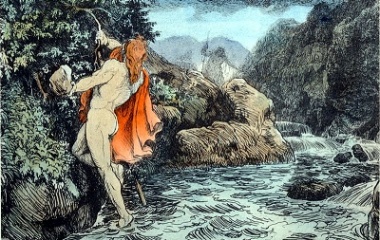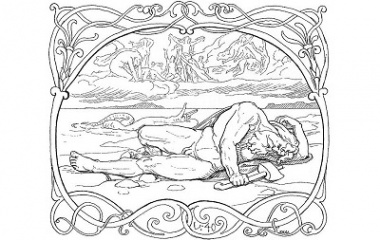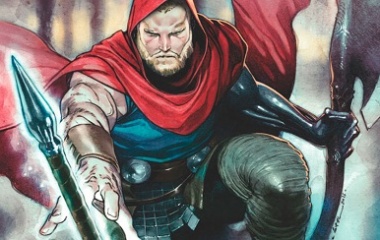- Pronunciation: TH-or
- Origin: Norse
- Role: God
- Symbol: Hammer
- Wife: Sif
- Children: Thrud, Magni, Moi
- Other Names: Thunderer
Who Is Thor?
Thor is a Norse god associated with the protection of mankind. He is well-recognized for his hammer which he used to control the lightning, thunder, and storms. He was incredibly strong and feared by many, even though he was interested in preserving the health and happiness of mankind.
Purpose
Thor represented very many traits and characteristics. It is believed that he symbolized the three main pillars of manhood, being provide, protect, and procreate. Thor wasn’t known by his followers as a gentle or loving god but he was still good. He used his strength and manly traits to protect the people. He also defended his own honor, along with those around him. He was known as the ultimate defender. He provided for his family, improvising when necessary. Even though the details on his family are blurry, we do know that he had children and supported them.
Origins
Thor’s roots can be traced to several different areas. Thor is believed to have stemmed from the Proto-Indo-European religions. He was mentioned several times throughout German recorded history, from the Roman occupation of the area to the Migration Period. He was most popular during the Viking Age. Many of his myths were recorded in Iceland.
He is still acknowledged today in Germanic regions. He also has a lasting legacy in a day of the week. Thursday refers to “Thor’s day” from Old English
Legends and Stories
Thor was known for his power and strength, which is evident in his myths. His muscle and symbolic tools allowed him to overcome his enemies. The following myths show how Thor used his quick thinking and strength to reign supreme over his challengers.
The Feast
Odin, Thor’s father, was near Jotunheim when he ran into the giant Hrungnir. Odin challenged the giant to a race back to Asgard on their horses. Odin’s eight-legged stallion, Sleipnir, easily won the race against Hrungnir. Despite this, the giant was still invited to stay for a giant feast. He accepted the invitation and spent the evening eating and drinking. He became drunk and began to declare he would destroy Asgard but not before capturing the town’s goddesses. This included Sif, Thor’s wife.
Even though Hrungnir was joking, Thor was not amused. He challenged the giant to a fight. He agreed but only if they could meet in Jotunheim so he could retrieve his weapons. Hearing of the impending battle, the other giants built a truly impressive clay figure. It was 30 miles high and 10 miles wide. The giants brought the figure to life so that it could fight alongside Hrungnir. Thor was not intimidated by the figure. In fact, the clay giant fled in fear when he saw Thor.
Thor then charged Hrungnir. He threw his hammer at the giant. At the same time, Hrungnir threw a giant whetstone at the god. The hammer broke the whetstone and then crushed Hrungnir’s head. Thor was victorious.
The Battle with Set
In another myth involving Thor’s power, Loki, known for his curious nature, was flying in the form a falcon. During his explorations, he was captured by a giant named Geirrod. He refused to release the god until Thor came to see the giant. Thor agreed to the meeting, thinking there was no danger involved, and left without his hammer. He happened to visit Grid, a friendly giantess, on his way. She told him that Geirrod planned to kill him and lent Thor her unbreakable staff.
When Thor arrived to see Geirrod, he was escorted to a chamber where there was a single chair. He sat down and the chair began to magically rise towards the ceiling, where he would certainly be crushed. He used Grid’s staff to force himself back down. Suddenly, he heard two loud cracks along with loud screaming. He looked down to see that magic wasn’t lifting the chair. Instead, it was Gerrid’s daughters. Thor had cracked both their backs while pushing the chair down.
Furious, Geirrod came into the chamber and promptly threw a molten iron rod at Thor. Thor easily caught the rod, forcing Geirrod to hide behind a pillar. Thor threw it, breaking the pillar and hitting the giant.
Family
Thor’s father was Odin, the god of war and death. He was also known as the god of poetry and wisdom. Odin only had one eye, as he traded the missing one for a drink from the Well of Wisdom. This made him incredibly knowledgeable. He carried a spear named Gungnir, which never missed its target.
Thor’s mother was Jord. She was Odin’s mistress but they only had one child. Odin was married to Frigg and together, they had several children. Hoder, Hermod, Tyr, Bragi, and Balder are all half siblings of Thor. Jord was a goddess and known as the personification of the Earth.
Thor married Sif, the goddess of fertility. Despite this, they never had children together. Thor did have a mistress though named Jarnsaxa. Together, they had Magni, Modi, and Thrud.
Appearance
Much different from Hollywood’s interpretation of the god, Thor was known for his red beard and long flowing hair. His power is no secret based on his size and build. Most artistic representations of him show him with a ferocious appearance but despite this, he was still one of the most popular and well-received gods. Unlike his father, he didn’t require human sacrifices, making him well-loved by those who came to him.
Symbology
There are several symbols associated with Thor. First, thunderstorms are linked to the god. The Norse believed that Thor would ride on his chariot through the heavens during a thunderstorm. His chariot was pulled by two goats, one named Tanngrisni and the other named Tanngnost. His hammer, known as Mjollnir, would cause lightening to flash whenever it was thrown. The hammer symbolizes everything Thor stands for as it is to be passed down to his sons after his death. It was prophesized that Thor would die from the poison of a serpent during Gotterdammerung, the name for the end of the world in Norse mythology.
Thor also wore a belt, called Megingjard, which symbolizes his strength. The belt was said to double his already impressive power. Thor is also associated with his temper.










